2022 HYUNDAI KONA wiper blades
[x] Cancel search: wiper bladesPage 15 of 579
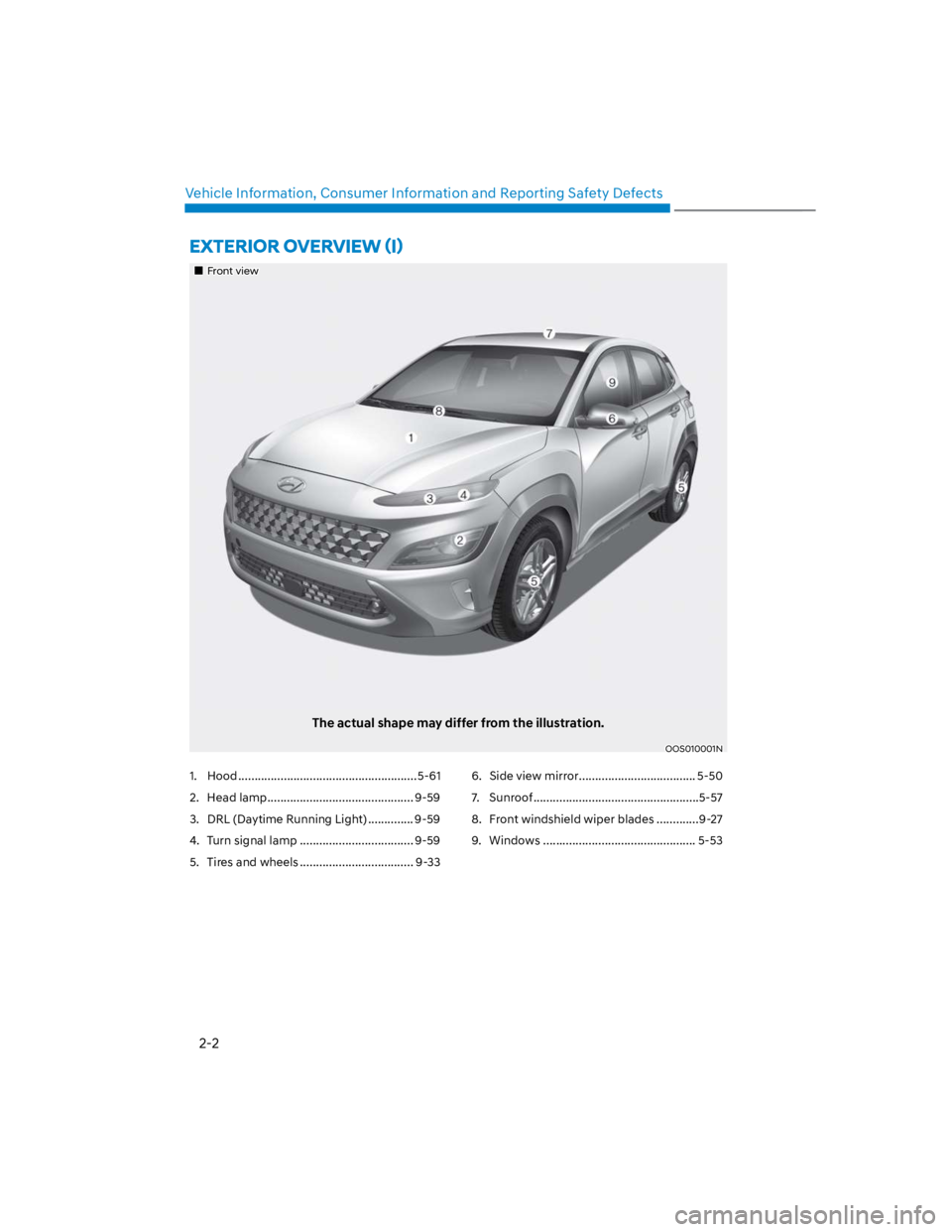
2-2
Vehicle Information, Consumer Information and Reporting Safety Defects
Front view
The actual shape may differ from the illustration.
OOS010001N
1. Hood ....................................................... 5-61
2. Head lamp ............................................. 9-59
3. DRL (Daytime Running Light) .............. 9-59
4. Turn signal lamp ................................... 9-59
5. Tires and wheels ................................... 9-33
6. Side view mirror .................................... 5-50
7. Sunroof ...................................................5-57
8. Front windshield wiper blades .............9-27
9. Windows ............................................... 5-53
Page 16 of 579
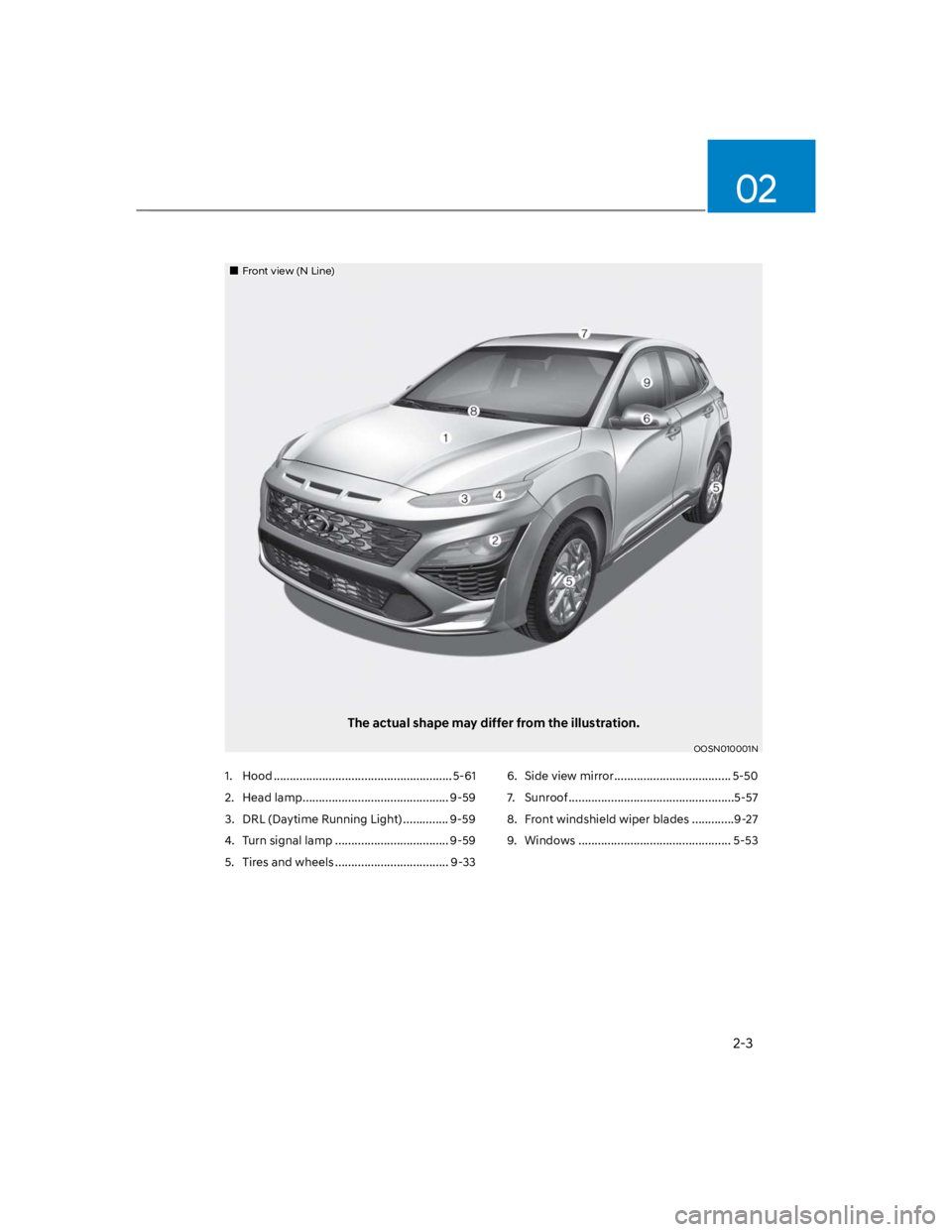
2-3
02
Front view (N Line)
The actual shape may differ from the illustration.
OOSN010001N
1. Hood ....................................................... 5-61
2. Head lamp ............................................. 9-59
3. DRL (Daytime Running Light) .............. 9-59
4. Turn signal lamp ................................... 9-59
5. Tires and wheels ................................... 9-33
6. Side view mirror .................................... 5-50
7. Sunroof ...................................................5-57
8. Front windshield wiper blades .............9-27
9. Windows ............................................... 5-53
Page 321 of 579
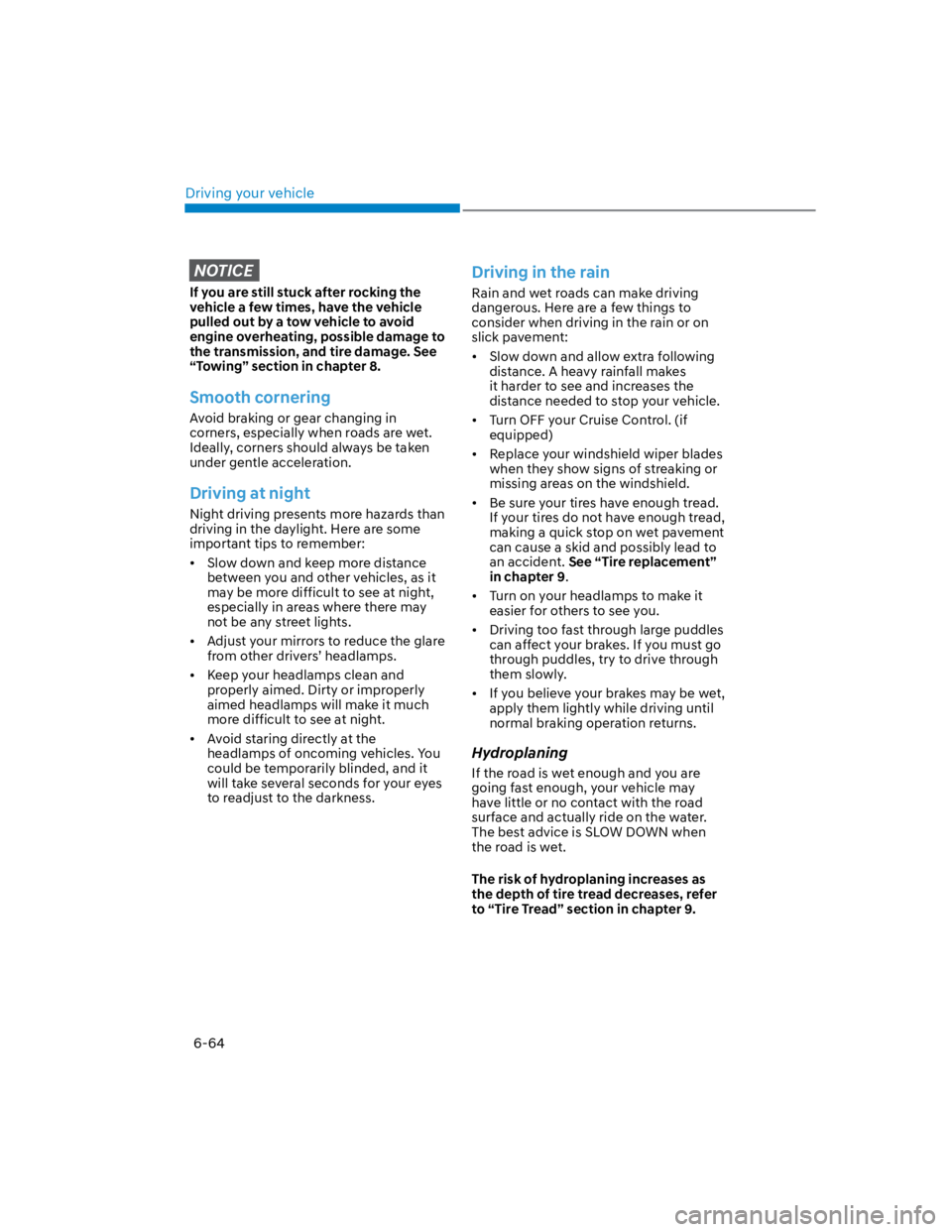
Driving your vehicle
6-64
NOTICE
If you are still stuck after rocking the
vehicle a few times, have the vehicle
pulled out by a tow vehicle to avoid
engine overheating, possible damage to
the transmission, and tire damage. See
“Towing” section in chapter 8.
Smooth cornering
Avoid braking or gear changing in
corners, especially when roads are wet.
Ideally, corners should always be taken
under gentle acceleration.
Driving at night
Night driving presents more hazards than
driving in the daylight. Here are some
important tips to remember:
Slow down and keep more distance
between you and other vehicles, as it
may be more difficult to see at night,
especially in areas where there may
not be any street lights.
Adjust your mirrors to reduce the glare
from other drivers’ headlamps.
Keep your headlamps clean and
properly aimed. Dirty or improperly
aimed headlamps will make it much
more difficult to see at night.
Avoid staring directly at the
headlamps of oncoming vehicles. You
could be temporarily blinded, and it
will take several seconds for your eyes
to readjust to the darkness.
Driving in the rain
Rain and wet roads can make driving
dangerous. Here are a few things to
consider when driving in the rain or on
slick pavement:
Slow down and allow extra following
distance. A heavy rainfall makes
it harder to see and increases the
distance needed to stop your vehicle.
Turn OFF your Cruise Control. (if
equipped)
Replace your windshield wiper blades
when they show signs of streaking or
missing areas on the windshield.
Be sure your tires have enough tread.
If your tires do not have enough tread,
making a quick stop on wet pavement
can cause a skid and possibly lead to
an accident. See “Tire replacement”
in chapter 9.
Turn on your headlamps to make it
easier for others to see you.
Driving too fast through large puddles
can affect your brakes. If you must go
through puddles, try to drive through
them slowly.
If you believe your brakes may be wet,
apply them lightly while driving until
normal braking operation returns.
Hydroplaning
If the road is wet enough and you are
going fast enough, your vehicle may
have little or no contact with the road
surface and actually ride on the water.
The best advice is SLOW DOWN when
the road is wet.
The risk of hydroplaning increases as
the depth of tire tread decreases, refer
to “Tire Tread” section in chapter 9.
Page 487 of 579
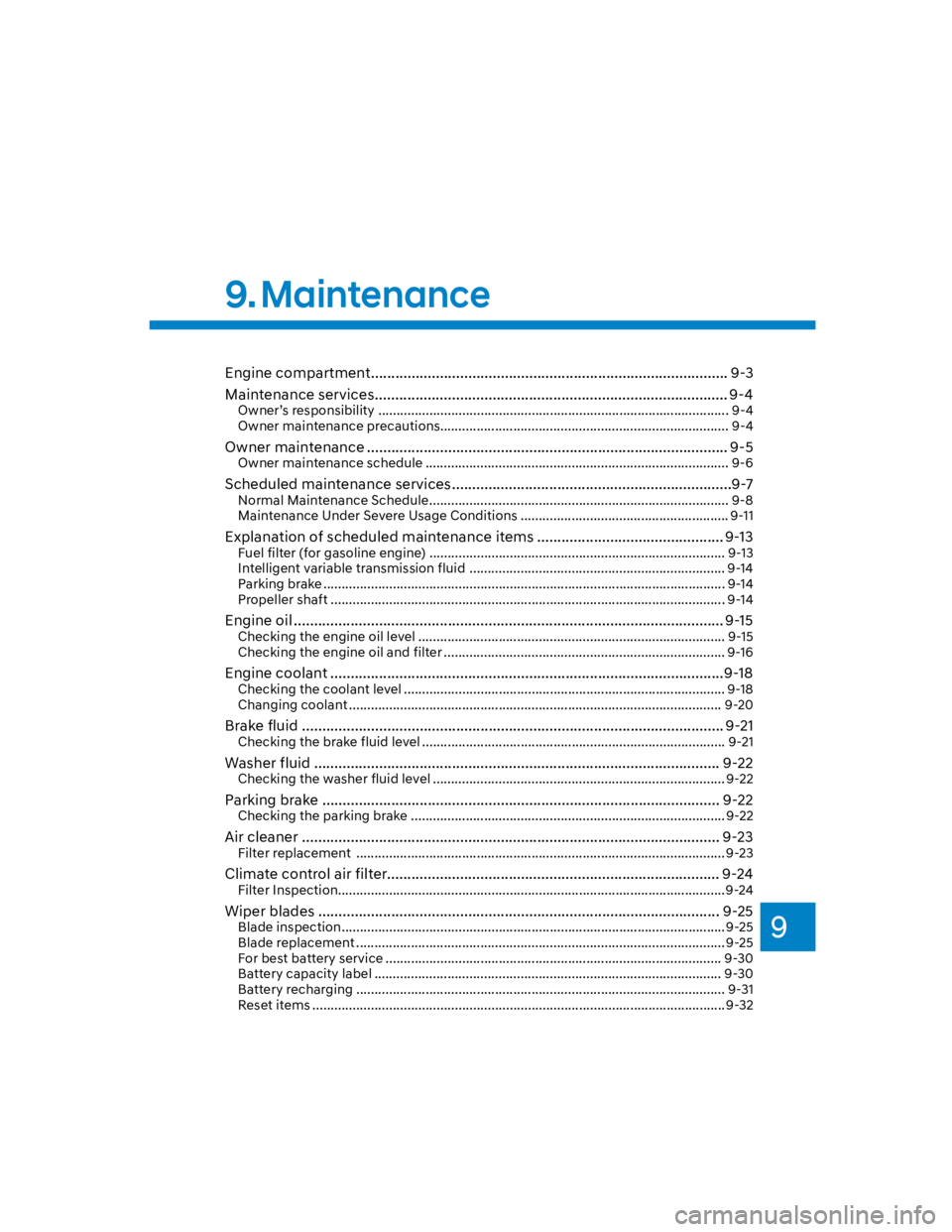
9
9. Maintenance
Engine compartment ........................................................................................ 9-3
Maintenance services ....................................................................................... 9-4
Owner’s responsibility ................................................................................................ 9-4
Owner maintenance precautions............................................................................... 9-4
Owner maintenance ......................................................................................... 9-5
Owner maintenance schedule ................................................................................... 9-6
Scheduled maintenance services .....................................................................9-7
Normal Maintenance Schedule .................................................................................. 9-8
Maintenance Under Severe Usage Conditions ......................................................... 9-11
Explanation of scheduled maintenance items .............................................. 9-13
Fuel filter (for gasoline engine) ................................................................................. 9-13
Intelligent variable transmission fluid ...................................................................... 9-14
Parking brake .............................................................................................................. 9-14
Propeller shaft ............................................................................................................ 9-14
Engine oil .......................................................................................................... 9-15
Checking the engine oil level .................................................................................... 9-15
Checking the engine oil and filter ............................................................................. 9-16
Engine coolant .................................................................................................9-18
Checking the coolant level ........................................................................................ 9-18
Changing coolant ...................................................................................................... 9-20
Brake fluid ........................................................................................................ 9-21
Checking the brake fluid level ................................................................................... 9-21
Washer fluid .................................................................................................... 9-22
Checking the washer fluid level ................................................................................ 9-22
Parking brake .................................................................................................. 9-22
Checking the parking brake ...................................................................................... 9-22
Air cleaner ....................................................................................................... 9-23
Filter replacement ..................................................................................................... 9-23
Climate control air filter.................................................................................. 9-24
Filter Inspection..........................................................................................................9-24
Wiper blades ................................................................................................... 9-25
Blade inspection ......................................................................................................... 9-25
Blade replacement ..................................................................................................... 9-25
For best battery service ............................................................................................ 9-30
Battery capacity label ............................................................................................... 9-30
Battery recharging ..................................................................................................... 9-31
Reset items ................................................................................................................. 9-32
Page 492 of 579

Maintenance
9-6
Owner maintenance schedule
When you stop for fuel:
Check the coolant level in the engine
coolant reservoir or the water-cooled
intercooler coolant reservoir.
Check the windshield washer fluid
level.
Check for low or under-inflated tires.
WARNING
Be careful when checking your coolant
level when the engine is hot. This may
result in coolant being blown out of the
opening and cause serious burns and
other injuries.
While operating your vehicle:
Note any changes in the sound of the
exhaust or any smell of exhaust fumes
in the vehicle.
Check for vibrations in the steering
wheel. Notice if there is any increased
steering effort or looseness in the
steering wheel, or change in its
straight-ahead position.
Notice if your vehicle constantly turns
slightly or “pulls” to one side when
traveling on smooth, level road.
When stopping, listen and check for
unusual sounds, pulling to one side,
increased brake pedal travel or “hard-
to-push” brake pedal.
If any slipping or changes in the
operation of your transmission occurs,
check the transmission fluid level.
Check the automatic transmission P
(Park) function.
Check the parking brake.
Check for fluid leaks under your
vehicle (water dripping from the air
conditioning system during or after
use is normal).
At least monthly:
Check coolant level in the engine
coolant reservoir.
Check the operation of all exterior
lights, including the stoplights, turn
signals and hazard warning flashers.
Check the inflation pressures of all
tires including the spare for tires that
are worn, show uneven wear, or are
damaged.
Check for loose wheel lug nuts.
At least twice a year: (i.e., every
Spring and Autumn)
Check radiator, heater and air
conditioning hoses for leaks or
damage.
Check windshield washer spray and
wiper operation. Clean wiper blades
with a clean cloth dampened with
washer fluid.
Check headlamp alignment.
Check muffler, exhaust pipes, shields
and clamps.
Check the seat belts for wear and
function.
At least once a year:
Clean body and door drain holes.
Lubricate door hinges and hood
hinges.
Lubricate door and hood locks and
latches.
Lubricate door rubber weather strips.
Check the air conditioning system.
Inspect and lubricate automatic
transmission linkage and controls.
Clean the battery and terminals.
Check the brake fluid level.
Page 511 of 579
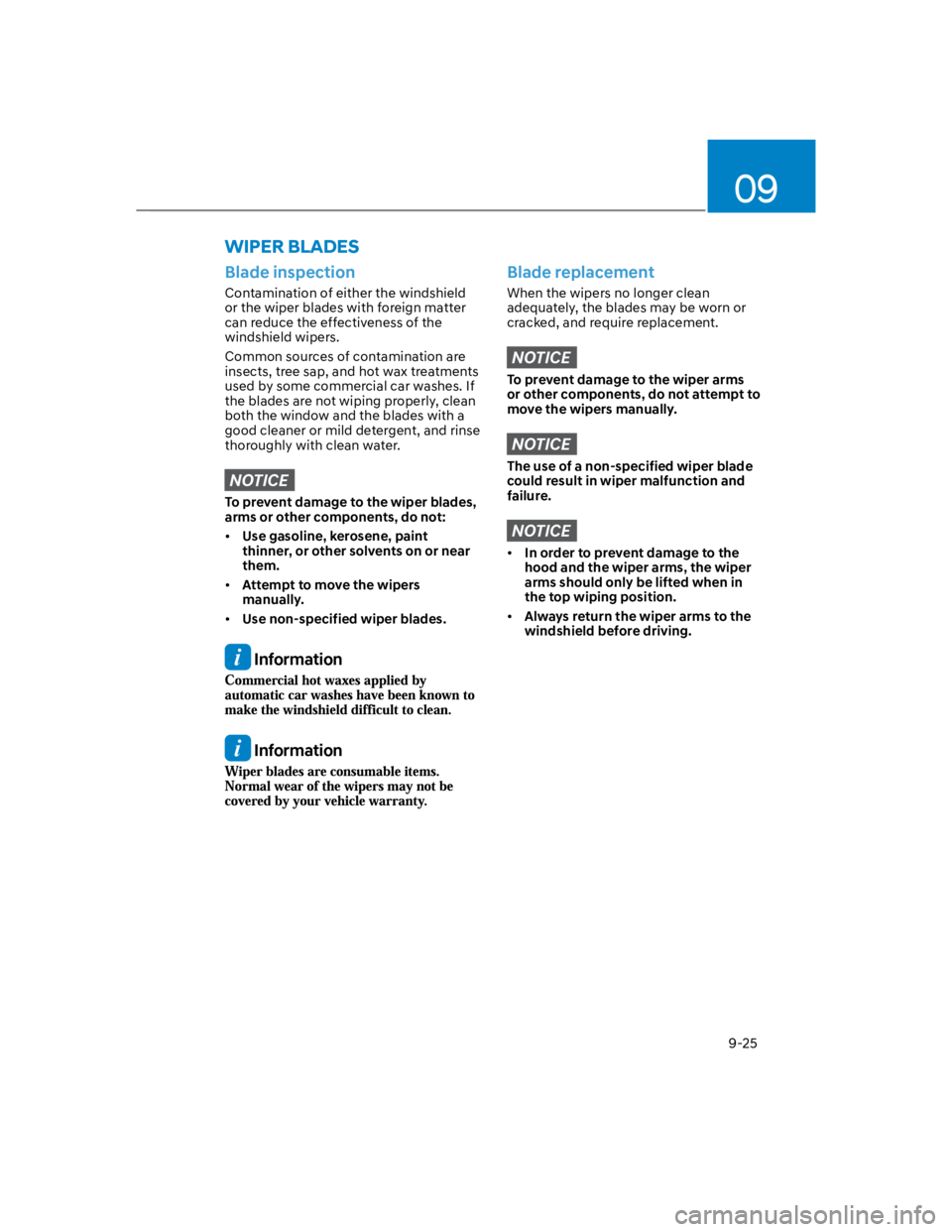
09
9-25
Blade inspection
Contamination of either the windshield
or the wiper blades with foreign matter
can reduce the effectiveness of the
windshield wipers.
Common sources of contamination are
insects, tree sap, and hot wax treatments
used by some commercial car washes. If
the blades are not wiping properly, clean
both the window and the blades with a
good cleaner or mild detergent, and rinse
thoroughly with clean water.
NOTICE
To prevent damage to the wiper blades,
arms or other components, do not:
Use gasoline, kerosene, paint
thinner, or other solvents on or near
them.
Attempt to move the wipers
manually.
Use non-specified wiper blades.
Information
Information
Blade replacement
When the wipers no longer clean
adequately, the blades may be worn or
cracked, and require replacement.
NOTICE
To prevent damage to the wiper arms
or other components, do not attempt to
move the wipers manually.
NOTICE
The use of a non-specified wiper blade
could result in wiper malfunction and
failure.
NOTICE
In order to prevent damage to the
hood and the wiper arms, the wiper
arms should only be lifted when in
the top wiping position.
Always return the wiper arms to the
windshield before driving.
WIPER BLADES
Page 514 of 579
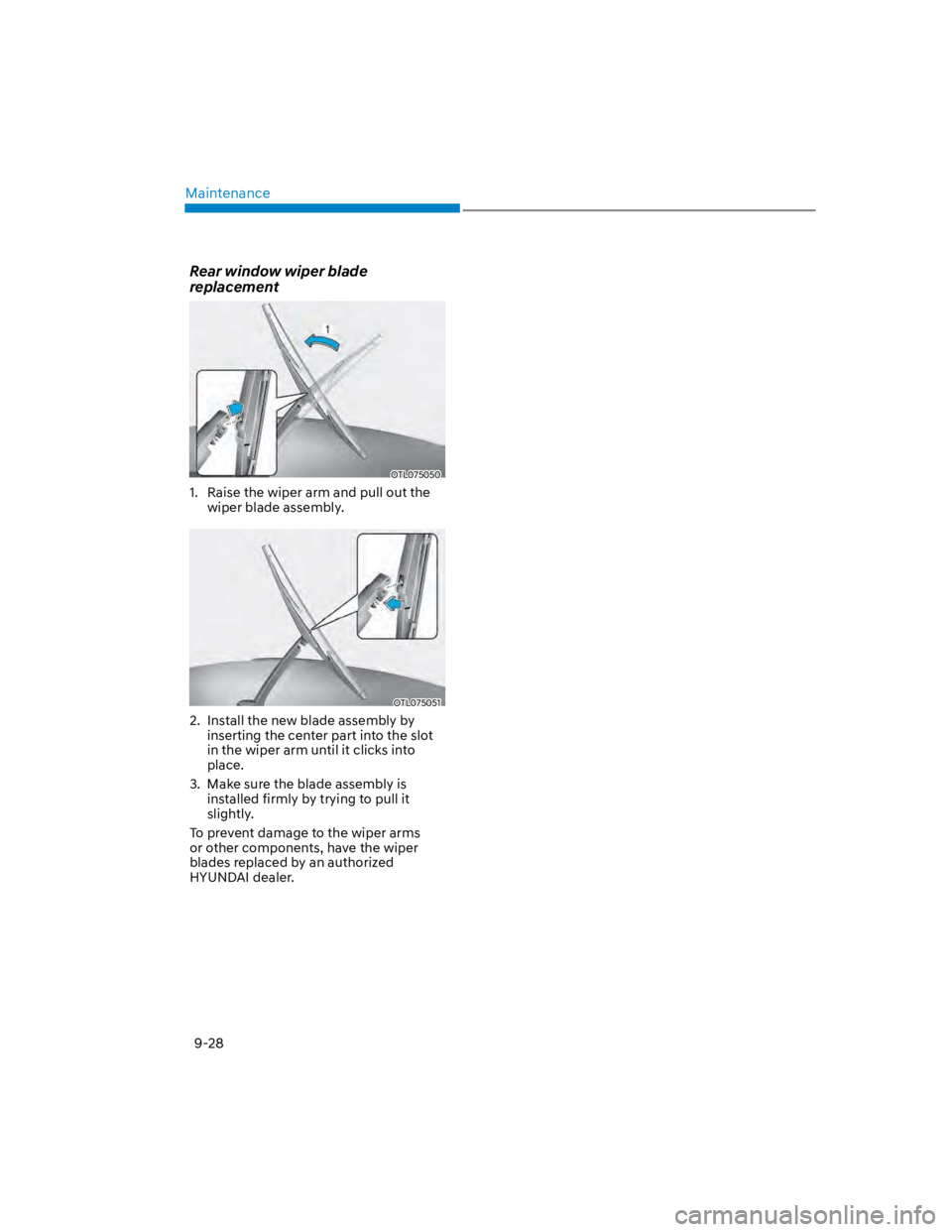
Maintenance
9-28
Rear window wiper blade
replacement
OTL075050
1. Raise the wiper arm and pull out the
wiper blade assembly.
OTL075051
2. Install the new blade assembly by
inserting the center part into the slot
in the wiper arm until it clicks into
place.
3. Make sure the blade assembly is
installed firmly by trying to pull it
slightly.
To prevent damage to the wiper arms
or other components, have the wiper
blades replaced by an authorized
HYUNDAI dealer.
Page 579 of 579
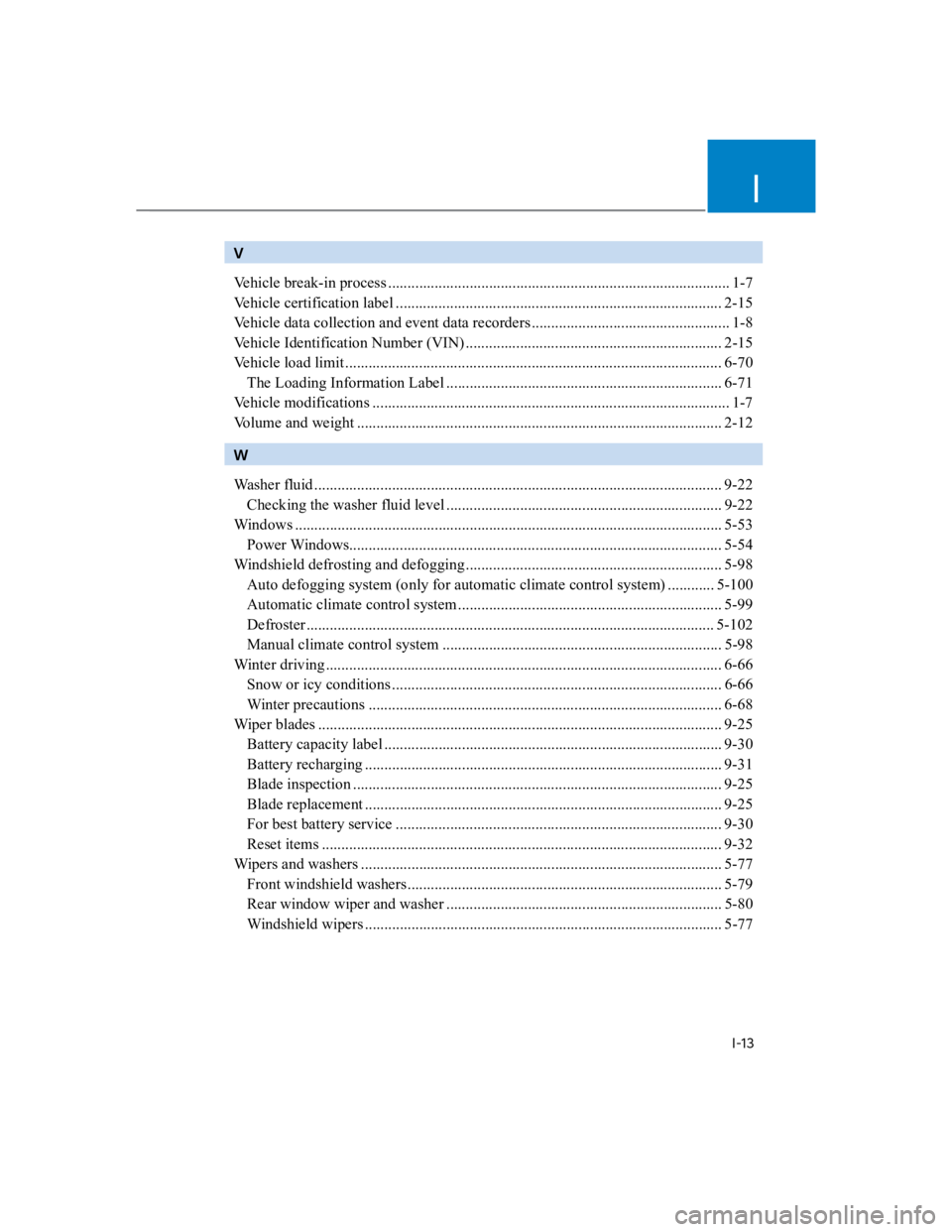
I
I-13
V
Vehicle break-in process ........................................................................................ 1-7
Vehicle certification label .................................................................................... 2-15
Vehicle data collection and event data recorders ................................................... 1-8
Vehicle Identification Number (VIN) .................................................................. 2-15
Vehicle load limit ................................................................................................. 6-70
The Loading Information Label ....................................................................... 6-71
Vehicle modifications ............................................................................................ 1-7
Volume and weight .............................................................................................. 2-12
W
Washer fluid ......................................................................................................... 9-22
Checking the washer fluid level ....................................................................... 9-22
Windows .............................................................................................................. 5-53
Power Windows................................................................................................ 5-54
Windshield defrosting and defogging.................................................................. 5-98
Auto defogging system (only for automatic climate control system) ............ 5-100
Automatic climate control system .................................................................... 5-99
Defroster ......................................................................................................... 5-102
Manual climate control system ........................................................................ 5-98
Winter driving ...................................................................................................... 6-66
Snow or icy conditions ..................................................................................... 6-66
Winter precautions ........................................................................................... 6-68
Wiper blades ........................................................................................................ 9-25
Battery capacity label ....................................................................................... 9-30
Battery recharging ............................................................................................ 9-31
Blade inspection ............................................................................................... 9-25
Blade replacement ............................................................................................ 9-25
For best battery service .................................................................................... 9-30
Reset items ....................................................................................................... 9-32
Wipers and washers ............................................................................................. 5-77
Front windshield washers ................................................................................. 5-79
Rear window wiper and washer ....................................................................... 5-80
Windshield wipers ............................................................................................ 5-77